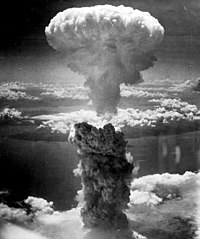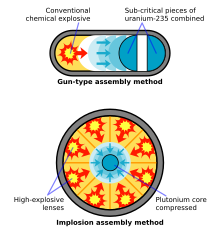
The mushroom cloud of the atomic bombing of Nagasaki, Japan in 1945 rose some 18 kilometers (11 miles) above the bomb's hypocenter.
A nuclear weapon is an explosive device that derives its destructive force from nuclear reactions, either fission or a combination of fission and fusion. Both reactions release vast quantities of energy from relatively small amounts of matter; a modern thermonuclear weapon weighing little more than a thousand kilograms can produce an explosion comparable to the detonation of more than a billion kilograms of conventional high explosive.[1] Even small nuclear devices can devastate a city. Nuclear weapons are considered weapons of mass destruction, and their use and control has been a major aspect of international policy since their debut.
In the history of warfare only two nuclear weapons have been detonated offensively, both near the end of World War II. The first was detonated on the morning of 6 August 1945, when the United States dropped a uranium gun-type device code-named "Little Boy" on the Japanese city of Hiroshima. The second was detonated three days later when the United States dropped a plutonium implosion-type device code-named "Fat Man" on the city of Nagasaki, Japan. These bombings resulted in the immediate deaths of around 120,000 people (mostly civilians) from injuries sustained from the explosion and acute radiation sickness, and even more deaths from long-term effects of (ionizing) radiation. The use of these weapons was and remains controversial. (See Atomic bombings of Hiroshima and Nagasaki for a full discussion.)
Since the Hiroshima and Nagasaki bombings, nuclear weapons have been detonated on over two thousand occasions for testing purposes and demonstration purposes. The only countries known to have detonated nuclear weapons – and that acknowledge possessing such weapons – are (chronologically) the United States, the Soviet Union (succeeded as a nuclear power by Russia), the United Kingdom, France, the People's Republic of China, India, Pakistan, and North Korea. Israel is also widely believed to possess nuclear weapons, though it does not acknowledge having them. For more information on these states' nuclear programs, as well as other states that formerly possessed nuclear weapons or are suspected of seeking nuclear weapons, see List of states with nuclear weapons.
Contents |
Types of nuclear weapons
There are two basic types of nuclear weapon. The first type produces its explosive energy through nuclear fission reactions alone. Such fission weapons also commonly referred to as atomic bombs or atom bombs (abbreviated as A-bombs), though their energy comes specifically from the nucleus of the atom.
In fission weapons, a mass of fissile material (enriched uranium or plutonium) is assembled into a supercritical mass—the amount of material needed to start an exponentially growing nuclear chain reaction—either by shooting one piece of sub-critical material into another (the "gun" method), or by compressing a sub-critical sphere of material using chemical explosives to many times its original density (the "implosion" method). The latter approach is considered more sophisticated than the former, and only the latter approach can be used if plutonium is the fissile material.
A major challenge in all nuclear weapon designs is to ensure that a significant fraction of the fuel is consumed before the weapon destroys itself. The amount of energy released by fission bombs can range between the equivalent of less than a ton of TNT upwards to around 500,000 tons (500 kilotons) of TNT.[2]
The second basic type of nuclear weapon produces a large amount of its energy through nuclear fusion reactions. Such fusion weapons are generally referred to as thermonuclear weapons or more colloquially as hydrogen bombs (abbreviated as H-bombs), as they rely on fusion reactions between isotopes of hydrogen (deuterium and tritium). However, all such weapons derive a significant portion – and sometimes a majority – of their energy from fission (including fission induced by neutrons from fusion reactions). Unlike fission weapons, there are no inherent limits on the energy released by thermonuclear weapons. Only six countries—United States, Russia, United Kingdom, People's Republic of China, France and India—have conducted thermonuclear weapon tests. (Whether India has detonated a "true," multi-staged thermonuclear weapon is controversial.)[3]

The basics of the Teller–Ulam design for a hydrogen bomb: a fission bomb uses radiation to compress and heat a separate section of fusion fuel.
Thermonuclear bombs work by using the energy of a fission bomb in order to compress and heat fusion fuel. In the Teller-Ulam design, which accounts for all multi-megaton yield hydrogen bombs, this is accomplished by placing a fission bomb and fusion fuel (tritium, deuterium, or lithium deuteride) in proximity within a special, radiation-reflecting container.
When the fission bomb is detonated, gamma and X-rays emitted first compress the fusion fuel, then heat it to thermonuclear temperatures. The ensuing fusion reaction creates enormous numbers of high-speed neutrons, which then can induce fission in materials which normally are not prone to it, such as depleted uranium. Each of these components is known as a "stage," with the fission bomb as the "primary" and the fusion capsule as the "secondary." In large hydrogen bombs, about half of the yield, and much of the resulting nuclear fallout, comes from the final fissioning of depleted uranium.[2]
By chaining together numerous stages with increasing amounts of fusion fuel, thermonuclear weapons can be made to an almost arbitrary yield; the largest ever detonated (the Tsar Bomba of the USSR) released an energy equivalent to over 50 million tons (50 megatons) of TNT. Most thermonuclear weapons are considerably smaller than this, due for instance to practical constraints in fitting them into the space and weight requirements of missile warheads.[4]
When the fission bomb is detonated, gamma and X-rays emitted first compress the fusion fuel, then heat it to thermonuclear temperatures. The ensuing fusion reaction creates enormous numbers of high-speed neutrons, which then can induce fission in materials which normally are not prone to it, such as depleted uranium. Each of these components is known as a "stage," with the fission bomb as the "primary" and the fusion capsule as the "secondary." In large hydrogen bombs, about half of the yield, and much of the resulting nuclear fallout, comes from the final fissioning of depleted uranium.[2]
By chaining together numerous stages with increasing amounts of fusion fuel, thermonuclear weapons can be made to an almost arbitrary yield; the largest ever detonated (the Tsar Bomba of the USSR) released an energy equivalent to over 50 million tons (50 megatons) of TNT. Most thermonuclear weapons are considerably smaller than this, due for instance to practical constraints in fitting them into the space and weight requirements of missile warheads.[4]
There are other types of nuclear weapons as well. For example, a boosted fission weapon is a fission bomb which increases its explosive yield through a small amount of fusion reactions, but it is not a fusion bomb. In the boosted bomb, the neutrons produced by the fusion reactions serve primarily to increase the efficiency of the fission bomb. Some weapons are designed for special purposes; a neutron bomb is a thermonuclear weapon that yields a relatively small explosion but a relatively large amount of neutron radiation; such a device could theoretically be used to cause massive casualties while leaving infrastructure mostly intact and creating a minimal amount of fallout.
The detonation of a nuclear weapon is accompanied by a blast of neutron radiation. Surrounding a nuclear weapon with suitable materials (such as cobalt or gold) creates a weapon known as a salted bomb. This device can produce exceptionally large quantities of radioactive contamination. Most variety in nuclear weapon design is in different yields of nuclear weapons for different types of purposes, and in manipulating design elements to attempt to make weapons extremely small.[2]
The detonation of a nuclear weapon is accompanied by a blast of neutron radiation. Surrounding a nuclear weapon with suitable materials (such as cobalt or gold) creates a weapon known as a salted bomb. This device can produce exceptionally large quantities of radioactive contamination. Most variety in nuclear weapon design is in different yields of nuclear weapons for different types of purposes, and in manipulating design elements to attempt to make weapons extremely small.[2]
See also
Notes
- ^ Specifically the US B83 nuclear bomb, with a yield of up to 1.2 Megatons.
- ^ a b c d e f The best overall printed sources on nuclear weapons design are: Hansen, Chuck. U.S. Nuclear Weapons: The Secret History. San Antonio, TX: Aerofax, 1988; and the more-updated Hansen, Chuck. Swords of Armageddon: U.S. Nuclear Weapons Development since 1945. Sunnyvale, CA: Chukelea Publications, 1995.
- ^ On India's alleged hydrogen bomb test, see Carey Sublette, What Are the Real Yields of India's Test?.
- ^ Sublette, Carey. "The Nuclear Weapon Archive". Retrieved on 2007-03-07.
- ^ See, for example: Feldman, Noah. "Islam, Terror and the Second Nuclear Age," New York Times Magazine (29 October 2006).
- ^ Stephen I. Schwartz, ed., Atomic Audit: The Costs and Consequences of U.S. Nuclear Weapons Since 1940. Washington, D.C.: Brookings Institution Press, 1998. See also Estimated Minimum Incurred Costs of U.S. Nuclear Weapons Programs, 1940-1996, an excerpt from the book.
- ^ In the United States, the President and the Secretary of Defense, acting as the National Command Authority, must jointly authorize the use of nuclear weapons.
- ^ Richelson, Jeffrey. Spying on the bomb: American nuclear intelligence from Nazi Germany to Iran and North Korea. New York: Norton, 2006.
- ^ Gusterson, Hugh, "Finding Article VI" Bulletin of the Atomic Scientists (8 January 2007).
- ^ Q&A with Scott Kirsch: Digging with bombs
- ^ Can past nuclear explosions help detect forgeries?
References
- Bethe, Hans Albrecht. The Road from Los Alamos. New York: Simon and Schuster, 1991. ISBN 0-671-74012-1
- DeVolpi, Alexander, Minkov, Vladimir E., Simonenko, Vadim A., and Stanford, George S. Nuclear Shadowboxing: Contemporary Threats from Cold War Weaponry. Fidlar Doubleday, 2004
- Glasstone, Samuel and Dolan, Philip J. The Effects of Nuclear Weapons (third edition). Washington, D.C.: U.S. Government Printing Office, 1977. Available online (PDF).
- NATO Handbook on the Medical Aspects of NBC Defensive Operations (Part I - Nuclear). Departments of the Army, Navy, and Air Force: Washington, D.C., 1996
- Hansen, Chuck. U.S. Nuclear Weapons: The Secret History. Arlington, TX: Aerofax, 1988
- Hansen, Chuck. The Swords of Armageddon: U.S. nuclear weapons development since 1945. Sunnyvale, CA: Chukelea Publications, 1995. [1]
- Holloway, David. Stalin and the Bomb. New Haven: Yale University Press, 1994. ISBN 0-300-06056-4
- The Manhattan Engineer District, "The Atomic Bombings of Hiroshima and Nagasaki" (1946)
- Smyth, Henry DeWolf. Atomic Energy for Military Purposes. Princeton, NJ: Princeton University Press, 1945. (Smyth Report – the first declassified report by the US government on nuclear weapons)
- The Effects of Nuclear War. Office of Technology Assessment, May 1979.
- Rhodes, Richard. Dark Sun: The Making of the Hydrogen Bomb. New York: Simon and Schuster, 1995. ISBN 0-684-82414-0
- Rhodes, Richard. The Making of the Atomic Bomb. New York: Simon and Schuster, 1986 ISBN 0-684-81378-5
- Weart, Spencer R. Nuclear Fear: A History of Images. Cambridge, MA: Harvard University Press, 1988.
External links
| Wikimedia Commons has media related to: Nuclear weapons |
| Wikinews has related news: Nuclear proliferation |
This audio file was created from a revision dated 2005-12-01, and does not reflect subsequent edits to the article. (Audio help)




